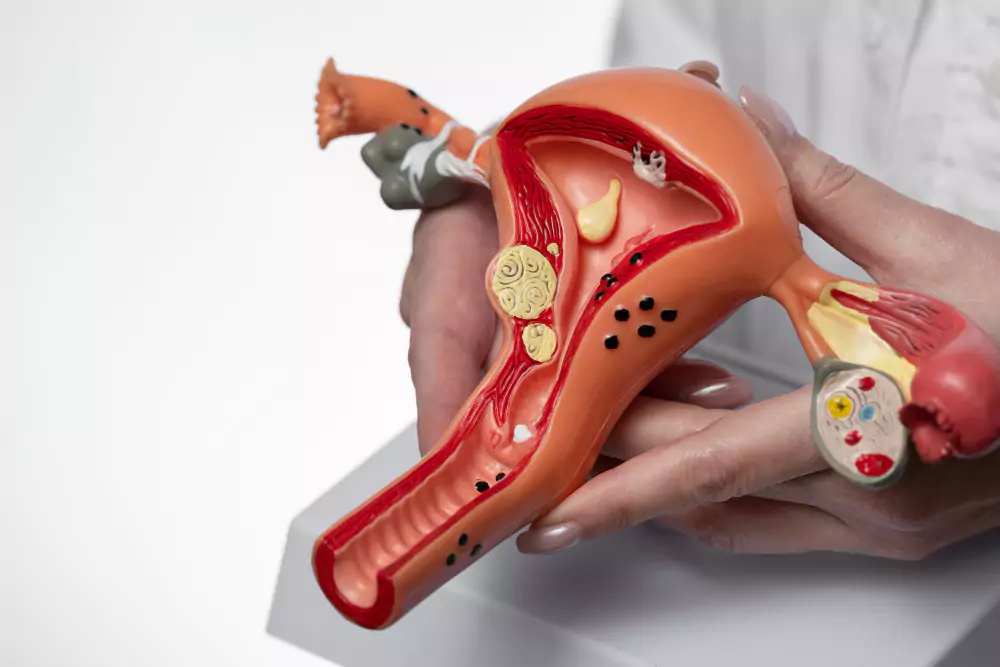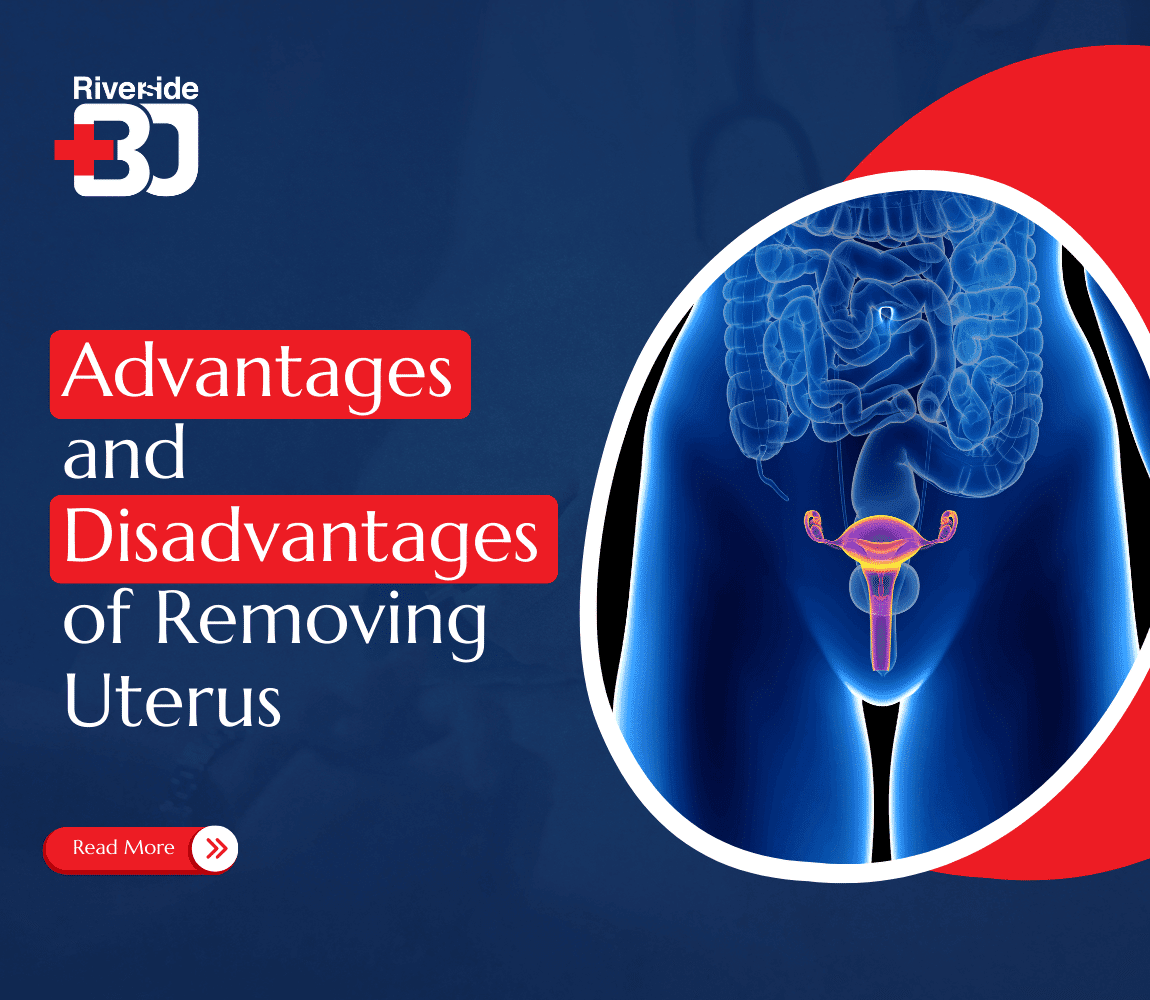Contemplating a hysterectomy is a significant decision, as the advantages and disadvantages of removing uterus can profoundly impact a woman’s health and lifestyle. This surgical procedure requires careful consideration to understand its long-term effects.
- According to the Circle Health Group, in the UK, approximately 55,000 hysterectomy operations are performed annually.
- The Global Data reported that in 2022, the total number of hysterectomy procedures conducted in the UK was 41,511.
- Moreover, as per NPEU, the incidence of peripartum hysterectomy in the UK was 4.1 cases per 10,000 births in 2005-6.
These statistics highlight the prevalence of this procedure and underscore the importance of understanding its implications.
In this blog, we will explore the advantages and disadvantages of removing uterus. We will discuss its types, benefits, risks, and surgical approaches to help you make an informed decision.

What is a Hysterectomy?
A hysterectomy is a surgical procedure that removes the uterus and makes pregnancy impossible. Doctors often recommend it for conditions like fibroids, endometriosis, or cancer.
However, there are many advantages and disadvantages of removing uterus. Hence, individuals must decide based on their health factors.
Some women undergo this surgery due to chronic pelvic pain, excessive bleeding, or uterine prolapse. Doctors often explore other treatments before considering removal. Yet, when symptoms persist, they recommend a hysterectomy.
Since the advantages and disadvantages of hysterectomy vary, understanding its impact is essential. The absence of a uterus affects the production of hormones, menstrual cycles, and overall health. Therefore, consulting a specialist is crucial.
Understanding what a hysterectomy entails is essential, but knowing its different types helps determine the most suitable option.
What Are The Different Kinds Of Hysterectomy?
Different types of hysterectomy exist, each addressing a specific medical condition. Since the advantages and disadvantages of removing uterus vary, choosing the right procedure depends on individual health needs.
Understanding these variations helps determine the most appropriate treatment.
- Total Hysterectomy:
A total hysterectomy removes both the uterus and cervix. As a result, it prevents conditions like fibroids and cancer.
In discussing the advantages and disadvantages of removing uterus, this procedure eliminates menstruation. Further, eliminating related discomfort.
However, they may face hormonal changes affecting long-term health. Therefore, this procedure is widely recommended for severe gynaecological conditions.
- Supracervical Hysterectomy:
This surgery removes the upper part of the uterus while leaving the cervix intact.
It helps maintain pelvic support and reduces potential post-surgical complications. Nevertheless, regular cervical cancer screenings remain necessary.
Among all procedures, it balances the advantages and disadvantages of removing uterus, preserving some natural functions.
- Total Hysterectomy With Bilateral Salpingo-Oophorectomy:
The advantages and disadvantages of hysterectomy are carefully considered in this procedure. This is because this procedure involves the removal of the uterus, fallopian tubes, and ovaries.
It effectively eliminates potential threats and is often recommended for those at high risk of cancer. However, sudden menopause may occur and cause hormonal shifts that require management.
Additionally, keeping the advantages and disadvantages of removing uterus in mind, this surgery impacts bone and heart health. Hence, making post-operative care essential.
- Radical Hysterectomy With Bilateral Salpingo-Oophorectomy:
This complex procedure removes the uterus, cervix, fallopian tubes, ovaries, and nearby tissues.
It is primarily used for aggressive cancers and improves the chances of survival. However, it has a longer recovery period and permanent hormonal changes.
Despite its challenges, it remains necessary for certain cancer patients. Evaluating the advantages and disadvantages of hysterectomy helps patients prepare for life after surgery.
Each procedure has its own advantages and disadvantages of removing uterus, and affects reproductive health differently. Thus, making medical advice crucial.
The next section discusses post-surgery recovery and lifestyle adjustments.

The Pros of Hysterectomy
Understanding the advantages of a hysterectomy helps in making an informed choice. This procedure offers relief from various medical conditions, but it also brings permanent changes.
While some benefits significantly improve health, assessing the advantages and disadvantages of removing uterus remains essential. Some of the major advantages of a hysterectomy are:
- Eliminates Chronic Pain and Heavy Bleeding:
The disadvantages and advantages of removing uterus impact women suffering from fibroids or endometriosis. This surgery eliminates severe pain and prolonged bleeding, hence enhancing the quality of daily life.
When treatments fail, hysterectomy remains the only lasting option. By removing chronic discomfort, women regain both physical comfort and mental well-being. Therefore, they are able to lead a healthier and more fulfilling life overall.
- Reduces Cancer and Disease Risks:
For women facing a high risk of uterine or cervical cancer, a hysterectomy serves as prevention. Considering the advantages and disadvantages of removing uterus, it eliminates the chance of these conditions occurring, providing lasting protection.
Additionally, those with severe infections may find this procedure to be a permanent and effective solution.
While the disadvantages and advantages of removing uterus should be considered, reducing life-threatening risks remains an undeniable advantage.
Ultimately, preventative measures like this often improve longevity and overall health.
- No More Menstrual Discomfort and Hormonal Imbalances:
Among the advantages and disadvantages of removing uterus, menstruation stops permanently after a hysterectomy. As a result, it removes painful cramps and irregular cycles.
Furthermore, without a uterus, monthly hormonal fluctuations decrease and prevents severe mood swings.
For women struggling with unbearable periods, this surgery provides lasting comfort.
A complete relief from unpredictable cycles is a significant benefit. Additionally, a more stable hormonal balance results in enhanced emotional and physical well-being.
- Enhances Overall Quality of Life and Energy Levels:
Once the uterus is removed, women often experience increased energy levels on a daily basis. Without the pain, discomfort, or hormonal imbalances, they are able to focus on their daily activities better.
As a result, emotional well-being improves due to reduced anxiety caused by medical conditions.
Although weighing the disadvantages and advantages of uterus removal is crucial, long-term quality of life often improves. As a result, many women find themselves living pain-free, with better health and stability overall.
Understanding the disadvantages and advantages of uterus removal is essential before making a decision. Although a hysterectomy has multiple benefits, there are also drawbacks to consider.
The next section will explore the cons among the advantages and disadvantages of removing uterus to provide a complete perspective.
The Cons of Hysterectomy
Understanding the advantages and disadvantages of removing uterus helps in making an informed decision. While the procedure resolves certain health issues, it also brings lifelong changes. Assessing the risks ensures that individuals are prepared for potential challenges.
Some of the major cons of a hysterectomy are-
- Hormonal Imbalances and Menopausal Symptoms:
Many women experience hormonal fluctuations after a hysterectomy. This subsequently leads to hot flashes and mood swings.
If the ovaries are removed, menopause occurs immediately, intensifying these symptoms. Thus, hormonal therapy becomes necessary in some cases.
Among the advantages and disadvantages of removing uterus, dealing with unexpected hormonal shifts is a major concern.
Furthermore, sudden changes in estrogen levels may impact bone density and overall health.
- Increased Risk of Cardiovascular and Bone Problems:
Studies indicate that women who undergo a hysterectomy face a higher risk of heart disease, as Oestrogen plays a key role in cardiovascular health.
Subsequently, its decline weakens arteries so it gets important to follow some practical tips for a healthy heart.
Not only that, but reduced hormone levels accelerate bone loss.
Thus, understanding the advantages and disadvantages of removing uterus is crucial. The procedure can relieve chronic pain or excessive bleeding, but may lead to long-term health risks.
Moreover, the possibility of osteoporosis is alarming. Hence, general medicine and medical support is necessary to manage these long-term risks.
- Irreversible Loss of Fertility and Emotional Impact:
Since the uterus is removed, natural pregnancy becomes impossible after a hysterectomy. For women planning to conceive, this surgery eliminates all chances of biological motherhood. Additionally, the psychological impact can be overwhelming.
Considering the advantages and disadvantages of removing uterus, losing reproductive ability remains an emotional struggle.
Many women require counselling to navigate these profound changes.
- Possible Surgical Complications and Recovery Challenges:
Like any major procedure, a hysterectomy carries risks such as infections or excessive bleeding. Some women experience bladder or bowel complications post-surgery. Additionally, recovery may take weeks, impacting daily life.
Although the advantages and disadvantages of removing uterus differ among individuals, risks from the surgery must be acknowledged.
For such cases, careful post-operative management provides a smoother healing process.
Weighing the advantages and disadvantages of removing uterus is essential before undergoing surgery. Although a hysterectomy provides relief from certain conditions, the long-term effects cannot be ignored.
The next section explores alternative treatments and less invasive options to consider.
What are the Different Approaches Used for Removing the Uterus and Ovaries?
Understanding surgical methods helps individuals assess the advantages and disadvantages of removing uterus effectively. Different approaches are used based on medical conditions and recovery expectations.
Choosing the right procedure depends on health factors and patient preferences.
- Vaginal Hysterectomy:
Surgeons perform a vaginal hysterectomy by removing the uterus through the vaginal canal without external incisions. This approach helps in quicker recovery and minimal scarring compared to open surgery.
However, it may not be suitable for larger uteri or specific medical conditions. While this method is less invasive, the procedures from the risks include infections and weakened pelvic support.
This factor contributes to the advantages and disadvantages of removing uterus for each patient.
- Laparoscopic Hysterectomy:
The advantages and disadvantages of removing uterus vary with laparoscopic surgery, which uses small abdominal incisions for a camera and surgical tools.
This method reduces postoperative pain and enables faster recovery than open procedures. However, not all patients qualify for this approach. While it minimises visible scars, potential risks include internal bleeding, gas retention, and temporary nerve irritation.
- Robot-Assisted Laparoscopic Hysterectomy:
Surgeon-controlled robotic arms enhance precision during hysterectomy, leading to minimal blood loss and fewer complications. This advanced technique surpasses traditional methods in accuracy and efficiency.
However, it requires specialized training and comes with higher costs. Access to this technology is also limited in many hospitals. This adds to the advantages and disadvantages of removing uterus through a robot-assisted surgery.
- Abdominal Hysterectomy:
A larger abdominal incision allows the removal of the uterus in complex cases. It is necessary for severe fibroids, cancer, or extensive tissue involvement. However, the recovery process takes longer due to surgical trauma.
Despite its effectiveness, this method has a higher risk of infection, post-operative pain, and scarring. Patients should consider alternative procedures if suitable for their condition.
Deciding on a surgical approach depends on the medical needs and recovery expectations. Each method has benefits and risks, requiring careful evaluation before proceeding.

Conclusion
Hysterectomy is a significant decision and has its own advantages and disadvantages of removing uterus. It impacts both physical and emotional well-being.
Each surgical approach comes with its own set of risks and benefits, making careful consideration essential. Understanding the advantages and disadvantages of removing uterus is crucial for making an informed choice.
Recovery can vary from person to person, but adopting a healthy lifestyle supports better healing and long-term outcomes. Hence, open discussions with specialists help patients choose the most suitable approach for their individual needs. It ensures peace of mind.
At Riverside B&J Hospital, our expert surgeons are here to guide you through every step. We offer personalised consultations to help you make confident, informed decisions and achieve the best possible outcome.
Contact our team today.
FAQs
What Are The Advantages Of Removing The Uterus?
The advantages of removing the uterus include relief from chronic conditions like fibroids. Furthermore, it helps reduce the risk of uterine cancer and improves the quality of life.
What Are The Disadvantages Of Removing Uterus?
The disadvantages of removing the uterus can include hormonal changes and potential fertility loss. Additionally, some women may experience emotional distress due to the procedure.
How Do The Advantages And Disadvantages Of Removing Uterus Vary?
The advantages and disadvantages of removing uterus vary depending on individual health. It is essential to consider personal medical history before making a decision.
What Are The Potential Risks Involved In Removing Uterus?
Potential risks of removing the uterus may include bleeding, infection, and damage to nearby organs. However, these risks can be minimised with proper pre-surgery planning and expert care.
Can The Advantages And Disadvantages Of Removing Uterus Affect Long-Term Health?
The advantages and disadvantages of removing uterus may impact bone density and heart health. Moreover, hormonal changes could influence overall well-being, making post-surgery care crucial.

